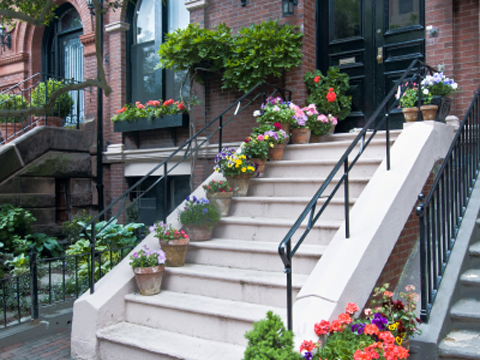As the weather begins to warm up, now is the time to get busy in the garden. What’s more, April 16th marks the start of National Gardening Week, which gives you six weeks to get your backyard into shape in time to celebrate. And it’s not just your eyes that will benefit from a blooming patch just outside your window. Gardening encourages biodiversity, according to the Royal Horticultural Society, and we depend on myriad of plants and animals for oxygen, fuel, food and medicine. Unfortunately, the use of pesticides and herbicides has contributed to a decline in UK wildlife populations. A third of UK bee colonies have vanished over the last two years, according to the Soil Association, due to unethical farming practices. But by ditching pesticides, and using a wide variety of plants in your garden, you can do your part to reverse the damage.
While country gardeners have a wealth of plants to choose from, and the space to plant them, urban gardeners aren’t so lucky. Thanks to limited planting space, pots have become an essential part of city gardens. But they do have a major downside: you can’t fit much in. Enter the raised bed. Although putting them up involves a bit of elbow grease and some heavy lifting, once assembled these structures provide the perfect solution for gardeners with limited space or poor soil. ‘These very small growing spaces can make a big difference to quality of life in urban areas with very limited open space,’ says Catherine Miller, of the Federation of City Farms and Community Gardens. ‘They are usually managed communally and offer good opportunities for people who may be socially isolated to meet others and get out of the house.’
 While some say size doesn’t matter, Leigh Hunt, principal horticultural adviser at the Royal Horticultural Society disagrees. ‘Size does matter. Large, wide raised beds can be hard to cultivate from the path as you would need to walk on to the bed to reach the middle. Instead, create beds that are only 1 to 1.2 metres wide, as the middle can then be reached from a path placed on either side. This saves walking on the soil and damaging the structure when it is wet.’ Sara Cork, deputy editor of Grow Your Own, agrees. ‘Most of us have been tempted to walk on the soil at some point or other,’ she says. ‘This isn't the best idea for plants, as it can cause compaction – a real problem for aeration and healthy growth.’ Cork says raised beds are designed for accessibility, and recommends making yours a couple of arms’ length wide so you can stand at the side while you work.
While some say size doesn’t matter, Leigh Hunt, principal horticultural adviser at the Royal Horticultural Society disagrees. ‘Size does matter. Large, wide raised beds can be hard to cultivate from the path as you would need to walk on to the bed to reach the middle. Instead, create beds that are only 1 to 1.2 metres wide, as the middle can then be reached from a path placed on either side. This saves walking on the soil and damaging the structure when it is wet.’ Sara Cork, deputy editor of Grow Your Own, agrees. ‘Most of us have been tempted to walk on the soil at some point or other,’ she says. ‘This isn't the best idea for plants, as it can cause compaction – a real problem for aeration and healthy growth.’ Cork says raised beds are designed for accessibility, and recommends making yours a couple of arms’ length wide so you can stand at the side while you work.
 Material matters
Material matters
So what should you use to build your raised bed? Because the materials you use can affect your plants, it pays to think carefully. ‘Gardeners are often worried that tanalised [preserved] timber, used to edge raised beds, contains metals such as chrome and arsenic that could leach into their crops,’ Hunt says. ‘Thankfully, since 2007, this type of tanalised timber should not be available in the UK and 'greener' preservatives are now used.’ If you’re still worried, un-treated timber is a great alternative, although the RHS warns that it could rot a more quickly in the soil. ‘There are a variety of other preservatives available, though gardeners looking for a natural alternative could try raw linseed oil,’ says Cork. ‘This is made from flax seed and can prevent cracking if applied annually – be warned, it may take some time to dry. Untreated wood is also an option for anyone wanting to avoid adding 'nasties' to their soil.’
Cork also recommended hardwoods (like ash and oak), which aren’t cheap but have the potential to last up to 20 years. Cheaper softwoods only last for up to five. Look for wood with Forest Stewardship Council (FSC) certification, as it has been responsibly harvested from a verified source. And if wood doesn’t spark your interest, bricks are an attractive alternative. Although, they do require some extra manual labour and a bit more experience in the garden.
Preparing the ground
First you must clear the area where you’d like to construct your flowerbed. Mark the dimensions on the ground, and saw the boards to the desired length, using guidance from the markings. Next dig a trench around the bed area in which to place your materials. Begin building your box by settling your boards or bricks into the trench vertically. Screw or nail the ends of the boards together to secure the frame of the box. Once the box is assembled, fill the first two layers of your flower bed with gravel and soil for better drainage. You can then fill the rest with soil and begin your planting. It’s also worth making sure you’ve gotten rid of any weed seeds, which can smother plants in a confined space. If you’d rather not pull weeds by hand, there are organic ways to get rid of them. ‘Spread well rotted organic matter, or black plastic, on beds or areas that aren't in use,’ Cork says. ‘The covering will smother weed seeds and prevent them from germinating.’
Top tips
Once the bed is built, it and its contents have to be maintained. ‘Their raised position may mean your beds dry out more speedily than you'd like,’ says Cork. ‘Annually adding well-rotted organic matter can help with water retention, as can mulches and regular irrigation. Unlike your average patch of soil, they'll also have to be built. If moving timber around doesn't sound appealing, look into lighter weight kits made from recycled plastic. Remember that the higher you make them, the more soil you'll need.’ ‘If you have three or more raised beds, they provide the ideal opportunity to carry out crop rotation,’ adds Hunt. ‘This is where you move the crops from one bed to the next each year. Standard rotation patterns include potatoes, followed by legumes (peas and beans), onions and root vegetables, and then brassicas (cabbage, kale etc).'
Elevating your flowerbeds also means you can grow your plants earlier in the year as raised beds drain better than ground level plant beds. And if you cover your beds with plastic earlier in the year (February/March), the soil will warm up more quickly and enable you to get a head start on your gardening.
| READ MORE... | |
 |
GREEN LIVING Lofty ambitions: why green roofs are the future of urban gardening Run out of space in your garden? Look to higher ground and you’ll find an eco-friendly solution |
 |
GREEN LIVING Top 10...garden wildlife From hedgehogs to house sparrows, British gardens are havens for native fauna. The RSPB’s Katie Fuller rounds up her favourites |
 |
GREEN LIVING Ten of the best…ways to get stuck into urban gardening Growing your own fruit and vegetables doesn’t have to involve huge amounts of space. As Hannah Corr explains, there are plenty of short cuts for city dwellers who want to get stuck in |
 |
GREEN LIVING The A-Z of chicken keeping Can’t tell your Marans from your Malays? Jeff Holman presents the A to Z guide to chicken keeping |
 |
GREEN LIVING Blooming marvellous: the spring bulbs to plant now October might not be the obvious month for spring planning, but if you want beautiful blooms come February, now is the time to start planting, says Ruth Styles |








